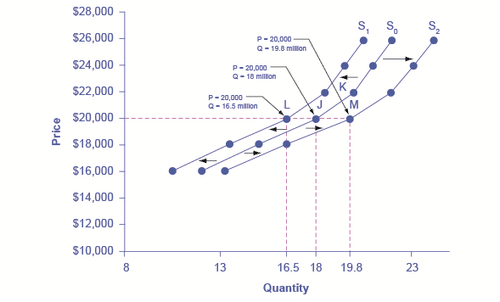3.9 生产理论理论
Section outline
-
The Theory of Production
::生产理论理论理论-
The theory of production examines the relationship between the factors of production (land, labor, capital, entrepreneur) and the output of goods and services. The theory of production is based on the "short run" or a period of production that allows production to change the amount of variable input, in this case, labor. The "long run" is a period of production that is long enough for producers to adjust various inputs to analyze the best mix of the factors of production.
Universal Generalizations
::普遍化-
The theory of production deals with the relationship between the factors of production and the output of goods and services.
::生产理论涉及生产要素与货物和服务产出之间的关系。 -
The law of variable proportions can explain how increasing units of a single input will cause the output to vary.
::可变比例法可以解释增加单一输入单位将如何导致产出变化。
Guiding Questions
::问 问 问 问 问 问 问 问 问 问 问 问 问 问 问 问 问 问 问 问 问 问 问 问 问 问 问 问 问 问 问 问 问 问 问 问 问 问 问 问 问 问 问 问 问 问 问 问 问 问 问 问 问 问 问 问 问 问 问 问 问 问 问 问 问 问 问 问 问 问 问 问 问 问 问 问 问 问 问 问 问 问 问 问 问 问 问 问 问 问 问 问 问 问 问 问 问 问-
Why is it important for an owner of a company to understand the theory of production?
::为什么公司所有人必须理解生产理论? -
What is the easiest factor of production to change in order to vary total product output?
::为了改变总产品产出,最容易改变的生产因素是什么?
Video: Diminishing Marginal Returns
::视频:缩小边际回归Video: Economies of Scale
::视频:规模经济Law of Variable Proportion
::变量比例法The Law of Variable Proportion can be best illustrated by using the "production function" for the concept that describes the relationship between changes in output to different amounts of a single input while all other inputs are held constant. This concept helps a producer determine the best use of resources to effect output. The basic model used by economists is the hypothetical production schedule to determine output when the number of workers changes. In this scenario, the company can calculate the total product, or total output, that the firm will produce.
::变量比例法最能用“生产功能”来说明变量比例法。 “生产功能”这个概念描述了产出变化与单项投入的不同数量之间的关系,而所有其他投入则保持不变。这个概念有助于生产者决定资源的最佳利用,以实现产出。经济学家使用的基本模型是假设的生产时间表,以决定工人人数变化时的产出。在这个假设中,公司可以计算公司将产生的总产品或总产出。Generally, there are three stages of production. Each stage impacts returns. Stage 1 begins when the first worker is hired, but there are not enough workers to produce efficiently enough to create a positive return. Until the company hires enough workers to run all of the machinery, this stage results in increasing returns. As long as each new worker contributes to the total output than the worker before, total output rises faster and faster.
::一般来说,生产分为三个阶段,每个阶段都会产生影响。第一阶段从雇用第一个工人开始,但没有足够的工人生产效率足以创造积极的回报。在公司雇用足够的工人管理所有机器之前,这一阶段会增加回报。只要每个新工人对总产出的贡献比工人之前更快,总产出就会迅速增长。Unfortunately, a company cannot continue in Stage 1 because as soon as it is discovered that adding additional workers increases output, the company continues to hire additional employees. By Stage 2 production output continues to rise, but at small and smaller increments. Soon additional workers hired may be needed to do things other than produce, like stock shelves or answer phones. The total production is slowing down so this stage is no longer producing increasing returns, but now it is diminishing returns.
::不幸的是,一家公司不能继续进入第一阶段,因为一旦发现增加工人会增加产出,该公司就继续雇用更多的雇员。 到第二阶段,生产产出会继续增加,但增加幅度较小。 很快可能需要雇用更多的工人从事生产以外的工作,比如股票架或接听电话。 总产量正在放缓,因此这个阶段不再产生不断增长的回报,但现在却在减少回报。At Stage 3 the company has hired too many workers and now the output is considered producing in negative returns. Too many workers get in each other's way and do not produce as much as in Stage 1 or even Stage 2. By Stage 3 the marginal output becomes negative and the total factory output decreases. The exact number of workers needed by a company can only be ascertained when the cost of adding each new worker is calculated. If the cost is low, then more workers can be hired. If the cost is high, the factory will need to consider how to produce the highest output amount in Stage 2 for the least amount of money.
::在第三阶段,公司雇用了太多的工人,而现在产出被认为是负回报。太多的工人相互影响,而没有生产到第一阶段甚至第二阶段的产量。到第三阶段,边际产出变为负值,工厂总产出下降。只有在计算每增加一名新工人的成本时,才能确定公司需要的工人的确切人数。如果成本低,就可以雇用更多的工人。如果成本高,工厂就需要考虑如何在第二阶段以最低金额生产最高产量。Once the output has been calculated the measure is known as "marginal product". Marginal product is the extra output or change in the total product caused by the addition of one more unit of variable input, in this case, the number of workers. In order to determine the optimal input used in production, the changes in marginal product are examined in the various stages of production. The stages of production analyze the increasing returns, diminishing returns, and the negative returns, to calculate the best use of resources and inputs to produce at an optimal level.
::一旦计算了产出,计算结果就被称为“边际产品”。边际产品是因增加一个可变投入单位而导致的总产品额外产出或变化,在这种情况下,是工人人数。为了确定生产中使用的最佳投入,在生产的各个阶段对边际产品的变化进行审查。生产阶段分析回报增加、回报减少和负回报,以计算最佳水平生产的资源和投入的最佳利用情况。How Production Costs Affect Supply
::生产成本如何影响供应A supply curve shows how quantity supplied will change as the price rises and falls, assuming ceteris paribus so that no other economically relevant factors are changing. If other factors relevant to supply do change, then the entire supply curve will shift. Just as a shift in demand is represented by a change in the quantity demanded at every price, a shift in supply means a change in the quantity supplied at every price.
::供应曲线显示供应量将如何随着价格的上涨和下跌而变化,假设是兽医价格的上涨和下跌,因此其他与经济相关的因素不会发生变化。 如果与供应相关的其他因素确实发生变化,那么整个供应曲线就会发生变化。 正如需求的变化代表着每价所需数量的改变,供应的转变意味着每价供应量的变化。In thinking about the factors that affect supply, remember what motivates firms: profits, which are the difference between revenues and costs. Goods and services are produced using combinations of labor, materials, and machinery, or what we call inputs or factors of production. If a firm faces lower costs of production while the prices for the good or service the firm produces remain unchanged, a firm’s profits go up. When a firm’s profits increase, it is more motivated to produce output, since the more it produces the more profit it will earn. So, when costs of production fall, a firm will tend to supply a larger quantity at any given price for its output. This can be shown by the supply curve shifting to the right.
::在思考影响供应的因素时,请记住企业的动机:利润,也就是收入和成本之间的差额。 商品和服务是用劳动力、材料和机械的组合生产,或者我们称之为投入或生产要素的组合生产。 如果公司在商品或服务价格不变的情况下面临较低的生产成本,公司生产利润就会上升。 当公司的利润增加时,公司更愿意生产产出,因为生产成本越多,它就越能产生利润。 因此,生产成本下降时,公司倾向于以任何特定价格为产出提供更大数量。 这可以通过向右转移的供应曲线来证明。Take, for example, a messenger company that delivers packages around a city. The company may find that buying gasoline is one of its main costs. If the price of gasoline falls, then the company will find it can deliver messages more cheaply than before. Since lower costs correspond to higher profits, the messenger company may now supply more of its services at any given price. For example, given the lower gasoline prices, the company can now serve a greater area and increase its supply.
::比如,一个在城市周围提供包裹的送信公司。公司可能发现购买汽油是其主要成本之一。 如果汽油价格下跌,公司就会发现它能够比以前更廉价地发送信息。 由于成本降低与利润增加相对应,送信公司现在可以以任何特定价格提供更多服务。 比如,由于汽油价格降低,公司现在可以服务更大的地区并增加供应。Conversely, if a firm faces higher costs of production, then it will earn lower profits at any given selling price for its products. As a result, a higher cost of production typically causes a firm to supply a smaller quantity at any given price. In this case, the supply curve shifts to the left.
::相反,如果一家公司面临较高的生产成本,那么它将以任何特定销售价格为其产品赚取较低的利润,因此,较高的生产成本通常导致一家公司以任何特定价格供应较少的数量,在这种情况下,供应曲线向左转移。Conversely, if a firm faces higher costs of production, then it will earn lower profits at any given selling price for its products. As a result, a higher cost of production typically causes a firm to supply a smaller quantity at any given price. In this case, the supply curve shifts to the left.
::相反,如果一家公司面临较高的生产成本,那么它将以任何特定销售价格为其产品赚取较低的利润,因此,较高的生产成本通常导致一家公司以任何特定价格供应较少的数量,在这种情况下,供应曲线向左转移。Consider the supply of cars, shown by curve S 0 in 1. Point J indicates that if the price is $20,000, the quantity supplied will be 18 million cars. If the price rises to $22,000 per car, ceteris paribus, the quantity supplied will rise to 20 million cars, as point K on the S 0 curve shows. The same information can be shown in table form, as in 1.
::以S0曲线1点J点显示的汽车供应情况为例。 J点J点表明,如果价格为20,000美元,供应量将为1,800万辆汽车。如果每辆车,即兽医轿车,价格上涨至22,000美元,供应量将上升到2,000万辆汽车,如S0曲线K点所示。同样的信息可以在表格表格中显示,与1点一样。- Shifts in Supply: A Car Example
Decreased supply means that at every given price, the quantity supplied is lower, so that the supply curve shifts to the left, from S 0 to S 1 . Increased supply means that at every given price, the quantity supplied is higher, so that the supply curve shifts to the right, from S 0 to S 2 .
::供应量的减少意味着,按每一给定价格,供应量都较低,因此供应曲线从S0向左移动。 供应量的增加意味着,按每一给定价格,供应量较高,供应曲线向右移动,从S0向S2。Price and Shifts in Supply: A Car Example
::供应价格和供应价格变化:一辆车实例Price
::价格价格价格Decrease to S 1
::减至S1Original Quantity Supplied S 0
::原供应数量Increase to S 2
::增加至S2$16,000
10.5 million
::1050万12.0 million
::1 200万13.2 million
::1 320万$18,000
13.5 million
::1 350万15.0 million
::1 500万16.5 million
::1 650万$20,000
16.5 million
::1 650万18.0 million
::1 800万19.8 million
::1980万$22,000
18.5 million
::1 850万20.0 million
::2 000万22.0 million
::2 200万$24,000
19.5 million
::1 950万21.0 million
::2,100,000,000,000,000,000,000,000,000,000,000,000,00023.1 million
::2 310万$26,000
20.5 million
::2 050万22.0 million
::2 200万24.2 million
::2 420万 2 420万Imagine that the price of steel, an important ingredient in manufacturing cars, rises. Now producing a car has become more expensive. At any given price for selling cars, car manufacturers will react by supplying a lower quantity. This can be shown graphically as a leftward shift of supply, from S 0 to S 1 , which indicates that at any given price, the quantity supplied decreases. In this example, at a price of $20,000, the quantity supplied decreases from 18 million on the original supply curve (S 0 ) to 16.5 million on the supply curve S 1 , which is labeled as point L.
::想象一下钢铁是汽车制造中的重要成分,钢铁的价格会上涨。 现在,生产汽车已经变得更贵了。 以任何特定的价格出售汽车,汽车制造商都会以较低的数量作出反应。 这可以从图形上表明供应的左向转移,从S0到S1, 这表明以任何特定价格供应的数量都会下降。 在这个例子中,以20,000美元的价格,供应量从原供应曲线(S0)上的1,800万下降到S1,650万,而供应曲线的标签是L点。Conversely, if the price of steel decreases, producing a car becomes less expensive. At any given price for selling cars, car manufacturers can now expect to earn higher profits, so they will supply a higher quantity. The shift of supply to the right, from S 0 to S 2 , means that at all prices, the quantity supplied has increased. In this example, at a price of $20,000, the quantity supplied increases from 18 million on the original supply curve (S 0 ) to 19.8 million on the supply curve S 2 , which is labeled M.
::反之,如果钢铁价格下降,汽车生产价格就会降低。 以出售汽车的任何特定价格计算,汽车制造商现在可以指望赚取更高的利润,这样他们就能提供更高的数量。 供应向右的转变,从S0到S2,意味着供应量按所有价格计算都有所增加。 以20,000美元的价格计算,供应量从原先供应曲线(S0)上的1,800万增加到S2供应曲线(S2)上的1,980万。Economists often use the ceteris paribus or “other things being equal” assumption: while examining the economic impact of one event, all other factors remain unchanged for the purpose of the analysis. Factors that can shift the demand curve for goods and services, causing a different quantity to be demanded at any given price, include changes in tastes, population, income, prices of substitute or complement goods, and expectations about future conditions and prices. Factors that can shift the supply curve for goods and services, causing a different quantity to be supplied at any given price, include input prices, natural conditions, changes in technology, and government taxes, regulations, or subsidies.
::经济学家经常使用 " 兽医价格 " 或 " 其他条件相同 " 的假设:在审查某一事件的经济影响时,为了分析的目的,所有其他因素保持不变。 能够改变商品和服务需求曲线、导致以任何特定价格要求不同数量的商品和服务的因素包括品味、人口、收入、替代或补充货物价格的变化,以及对未来条件和价格的预期。 能够改变商品和服务供应曲线、导致以任何特定价格提供不同数量的商品和服务的因素,包括投入价格、自然条件、技术变化以及政府税收、条例或补贴。Answer the self check questions below to monitor your understanding of the concepts in this section.
::回答下面的自我核对问题,以监测你对本节概念的理解。Self Check Questions
::自查问题1. What is the theory of production?
::1. 生产理论是什么?2. The theory of production is generally based on the "short run". Which input is the variable that is changed? Why this one?
::2. 生产理论一般以“短期运行”为基础,哪些输入是变化的变量?为什么是这一变量?3. What does the Law of Variable Proportions state? Give an example of this law.
::3. 《可变比例法》说明什么?请举例说明该法。4. What is the production function? How can it be illustrated?
::4. 生产功能是什么?如何加以说明?5. How many stages of production are there? Which stage is the best one to produce in?
::5. 有多少生产阶段?哪个生产阶段是最好的生产阶段?6. Explain how marginal product changes in the stages of production.
::6. 解释产品在生产阶段的边际变化。7. What are diminishing returns?
::7. 回报减少的是什么? -

